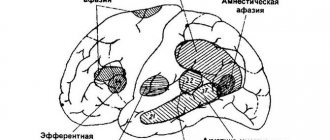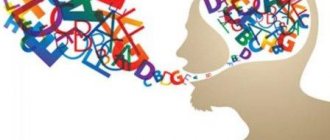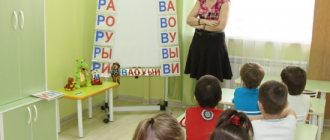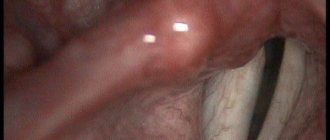Problems with using or understanding language (aphasia) appear, according to statistics from studies conducted by NABI (National Stroke Association), in 25 patients out of 100. Every fourth patient experiences difficulties associated with verbal communication - the ability to speak, write or understand spoken language. and written language. This indicates that acute cerebrovascular accident affected one or more language control centers.
Aphasia is a symptom of brain damage, not a disease. As individual as the picture of damage is, the manifestation of aphasia in each patient is as individual. This condition determines the individual nature of the selection of speech restoration techniques after a stroke for each patient.
Restorative learning for different forms of aphasia
The article discusses the program, specific steps and methods of remedial training for the following forms of aphasia: efferent motor aphasia, dynamic aphasia, afferent motor, sensory, acoustic-mnestic, semantic and amnestic aphasia.
Depending on the form of aphasia, the severity of the defect, the stage of the disease, and the individual characteristics of speech disorders, the integrated use of the considered methods for restoring oral and written speech will help a person adapt to life with this acquired disorder. Restorative learning is based on one of the most important properties of the brain—the ability to compensate. To restore impaired functions, both direct and bypass compensatory mechanisms are used.
Direct disinhibitory methods of work are mainly used in the individual stage of the disease and are designed to activate reserve intrafunctional capabilities. Bypass methods imply compensation based on the restructuring of the most impaired function due to cross-functional restructuring. In other words, the restorative effect is achieved through the introduction of new, “workaround” ways of performing certain speech or gnostic-praxic operations.
It is also necessary to strictly take into account the characteristics of each specific case of the disease.
Rehabilitation training is carried out according to a special, pre-developed program. The program should include certain tasks and corresponding work methods, differentiated depending on the form of aphasia (apraxia, agnosia), severity of the defect, stage of the disease, individual characteristics of speech disorders, but rehabilitation work in it should be carried out on all aspects of the impaired function, and not only over those who suffered primarily.
In addition, rehabilitation training should primarily be aimed at restoring the communication abilities of patients. It is necessary to involve the patient in communication not only in classes, but also in the family, as well as in public places.
Dysarthria after stroke
Also, speech dysfunction after a stroke manifests itself in the form of dysarthria, caused by impaired mobility of the muscles of the speech apparatus. Often this disorder is accompanied by problems with swallowing and breathing. There are also very severe cases in which the speech motor muscles are completely paralyzed. This condition is called anarthria.
The following symptoms are typical for this speech disorder after a stroke:
- difficult mobility of articulation organs;
- unintelligible and slurred speech;
- sound distortion;
- slurred speech with hesitation;
- slow or, on the contrary, accelerated rate of speech;
- changes in voice timbre;
- poor intonation, monotony;
- the patient's tendency to grimace.
There are several forms of this speech dysfunction. Each of them is determined by the specific location of the brain injury, as well as the extent of the hemorrhage or the size of the hematoma.
If a patient experiences dysarthria after a stroke, then speech function is restored with the help of a speech therapist. The specialist determines the form of the disorder and draws up a program of exercises, procedures and massage.
MOTOR APHASIA OF AFFERENT TYPE
Stage of severe disorders
1. Overcoming disorders of understanding situational and everyday speech:
- display of pictures and real images of the most commonly used objects and simple actions by their names, categorical and other characteristics. For example: “Show a table, a cup, a dog, etc.”, “Show pieces of furniture, clothing, transport, etc.” “Show someone who flies, who talks, who sings, who has a tail, etc.”
— classification of words by topic (for example: “Clothing”, “Furniture”, etc.) based on a subject picture;
— answers with an affirmative or negative gesture to simple situational questions. For example, “Is it winter now, summer..?”; "You live in Moscow?" and etc.
2. Disinhibition of the pronunciation side of speech:
- conjugate, reflected and independent pronunciation of automated speech series (ordinal counting, days of the week, months in order, singing with words, ending proverbs and phrases with a “hard” context), modeling situations that stimulate the pronunciation of onomatopoeic pronouns (“ah!” “oh” !" and so on.);
- conjugate and reflected pronunciation of simple words and phrases;
- inhibition of the speech embolus by introducing it into a word (ta, ta..-Tata, so), or into a phrase (ma..ma-mama...; this is mom).
3. Stimulating simple communicative types of speech:
— answers to questions in one or two words in a simple situational dialogue;
— modeling situations that contribute to the evocation of communicatively significant words (yes, no, want, will, etc.);
— answers to situational questions and composing simple phrases using a pictogram and a gesture accompanied by the pronunciation of simple words and phrases.
4. Stimulating global reading and writing:
— laying out captions under pictures (subject and subject);
- writing the most common words-ideograms, copying simple texts;
— conjugate reading of simple dialogues.
Moderate stage of disorders
1. Overcoming disorders of the pronunciation side of speech:
- isolating sounds from words;
— automation of individual articles in words with different syllabic structures;
— overcoming literal paraphasias by selecting first discrete and then gradually converging sounds in articulation.
2. Restoration and correction of phrasal speech:
- composing phrases based on a plot picture: from simple models (subject-predicate, subject-predicate-object) to more complex ones, including objects with prepositions, negative words, etc.;
- composing phrases on questions, on key words;
- exteriorization of grammatical-semantic connections of the predicate: “who?”, “why?”, “when?”, “where?” etc.;
— filling in gaps in a phrase with a grammatical change in a word;
— detailed answers to questions;
- compiling stories based on a series of plot pictures;
- retelling texts based on questions.
3. Work on the semantics of the word:
— development of generalized concepts;
- semantic play on words (subject and verbal vocabulary) by including them in various semantic contexts;
— filling in the gaps in a phrase;
- completing sentences with different words that are appropriate in meaning;
- selection of antonyms, synonyms.
4. Restoration of analytical-synthetic writing and reading:
- the sound-letter composition of the word, its analysis (one-two-three-syllable words) based on diagrams that convey the syllabic and sound-letter structure of the word, a gradual reduction in the number of external supports;
- filling in missing letters and syllables in words;
- copying words, phrases and small texts with an emphasis on self-control and independent error correction;>
- reading and writing from dictation of words with a gradually more complex sound structure, simple phrases, as well as individual syllables and letters;
- filling in missing words in texts when reading and writing, practiced in oral speech.
Stage of mild disorders
1. Further correction of the pronunciation aspect of speech:
— clarification with articles of individual sounds, especially affricates and diphthongs;
— differentiation of acoustic and kinesthetic images that are similar in articulation of sounds in order to eliminate literal paraphasias;
- practicing the purity of pronunciation of individual sounds in a sound stream, in phrases, with a combination of consonant sounds, in tongue twisters, etc.
2. Formation of detailed speech, complicated in semantic and syntactic structure:
- filling in the missing main sentence, as well as a subordinate sentence or subordinating conjunction in a complex sentence;
- answering questions with complex sentences;
- retelling texts without relying on questions;
— drawing up detailed plans for texts;
— preparation of thematic messages (short reports);
- speech improvisations on a given topic.
3. Further work to restore the semantic structure of the word:
- interpretation of individual words, mainly with abstract meaning;
— explanation of homonyms, metaphors, proverbs, phraseological units.
4. Work on understanding complex logical and grammatical figures of speech:
— execution of instructions, including logical and grammatical phrases;
— introduction of additional words, pictures, questions that facilitate the perception of complex speech structures.
5. Further restoration of reading and writing:
- reading and retelling expanded texts;
- dictations;
— written presentation of texts;
— writing letters, greeting cards, etc.;
- essays on a given topic.
1) Restoring the “articuleme-phoneme” connection
- writing letters corresponding to the names of sounds in expressive speech, reading these letters immediately after writing;
- isolating the first sound from simple words, fixing attention on the articulatory, acoustic, and then graphic image of this sound; independent selection of words for this sound and writing them;
- writing practiced sounds and syllables under dictation;
— identification of letters in different fonts;
— finding given letters in various texts (underlining, writing out).
2) Restoring the ability to sound-letter analysis of the composition of a word:
- dividing words into syllables, syllables into letters (sounds) based on various graphic schemes;
- highlighting any sound in a word;
- recalculation and listing of words by letter (orally);
- filling in gaps in words;
- writing words from letters given separately.
3) Restoring the skill of detailed written speech:
- writing words of different sound structures with and without support from an object picture: a) under dictation, b) when naming an object or action;
- writing proposals: a) from memory, b) from dictation, c) in the form of a written statement based on a plot picture for the purpose of communication with others;
- written statements and essays.
How to restore speech abilities after a stroke
After an illness, the patient learns to communicate again. Restoring speech lost after a stroke is a labor-intensive and lengthy process that requires multifaceted influence. Rehabilitation should be a comprehensive treatment that includes a variety of restorative activities. One of the main roles in the process of acquiring lost speech abilities is played by early access to a doctor. Help for the patient should be provided in the first hours after a stroke. It is also important to establish which aspects of speech have been damaged. The specialist must conduct diagnostic tests on the basis of which he makes a conclusion.
Rehabilitation methods for improving speech after cerebral hemorrhage are presented:
- taking certain medications;
- exercises to restore pronunciation;
- speech therapy;
- additional measures: surgery, physiotherapy, massage.
The success of rehabilitation also depends on the general environment in which the patient lives. He needs a peaceful atmosphere, away from noise and harsh sounds. Stress and worry will only slow down your recovery.
The patient’s relatives and people close to him should also contribute to the rehabilitation process. You need to constantly communicate with the patient, even if at first he cannot answer at all. A decisive attitude and perseverance must also be present in the patient himself. However, it is very important that speech rehabilitation after a stroke is systematic. You need to work intensively, but without overexerting yourself. The plan of procedures, classes, their duration and intensity are determined by specialists.
MOTOR APHASIA OF EFFERENT TYPE
Stage of severe disorders
The recovery program is the same as for afferent motor aphasia.
Moderate stage of disorders
1. Overcoming disorders of the pronunciation side of speech:
- development of articulatory switches within a syllable:
with vowels contrasting in articulation pattern (“a” – “u”, etc.); with various vowels, including soft ones; in syllables, for example,
M A A S T R E C E P T
- development of articulatory switching within a word: merging syllables into words with a simple, and later with a complex sound structure (for example, recipe, etc.);
- exteriorization of the sound-rhythmic side of the word, dividing words into syllables, highlighting the stress in the word, reproducing the outline of the word in the voice, selecting words with an identical sound-rhythmic structure, rhythmic pronunciation of words and phrases with the use of external supports - tapping, clapping, etc. , capturing various consonances, including the selection of rhyming words.
2. Restoration of phrasal speech:
— overcoming agrammatism at the level of the syntactic scheme of a phrase: composing “core” phrases of models like S (subject) + P (predicate); S+P+O (object) with the involvement of external supports-chips and their gradual “collapse”; highlighting the predicative center of the phrase; exteriorization of its semantic connections;
— overcoming agrammatism at the formal grammatical level: catching grammatical distortions—inflectional, prepositional, etc. in order to revive the sense of language; differentiation of singular and plural meanings, generic meanings, meanings of the present, past and future tenses of the verb; filling in missing grammatical elements in words; composing phrases based on plot pictures; answering questions with a simple phrase, grammatically formatted; retelling a simple text; stimulation to use incentive and interrogative sentences, various prepositional structures.
Stage of mild disorders
The program is the same as for the corresponding stage of afferent motor aphasia.
When restoring written speech in patients with motor aphasia of the efferent type, as a rule, the independent task of developing the “articulome-grapheme” connection is not highlighted.
The emphasis is on:
1. Restoring the ability to analyze the sound-rhythmic side of a word:
— differentiation of words by length and syllabic composition;
- highlighting the stressed syllable;
- selection of words identical in sound-rhythmic structure;
- highlighting identical elements in words - syllables, morphemes and, in particular, endings (underlining them, writing them out, etc.).
2. Restoring the ability to sound-letter analysis of the composition of a word.
3. Restoring the skill of merging letters into syllables, syllables into words.
4. Restoring the skill of detailed written speech (specific teaching methods - see the program for restoring learning for afferent motor aphasia - paragraphs 2,3,4).
Help from a speech therapist after a stroke
In the early stages of speech rehabilitation after a stroke, a speech therapist is required to be present at each session, helping the patient with exercises and monitoring the correctness of their implementation. If the recovery process is successful, the patient can perform them independently in the future. Although many people who have suffered a stroke also benefit from group speech therapy. For it to be effective, you must strictly adhere to the specialist’s recommendations and take a responsible approach to your exercises.
The method of speech therapy is selected based on the examination of the patient. The doctor checks the patient's response to the volume of speech, as well as the ability to evaluate and understand it. To restore articulation, a speech therapist involves different brain structures. Speech therapy exercises are divided into:
- Phonetic - aimed at improving the innervation and mobility of facial muscles.
- Semantic - represent a series of manipulations, the purpose of which is to activate the patient’s thinking. For example, he needs to continue the phrase or enter into an impromptu dialogue with the speech therapist on a certain topic.
- Visual - illustration method. With the help of pictures, the patient learns to find appropriate connections and sequences.
- Creative - singing, art therapy, learning to play musical instruments (playing the harmonica is especially useful).
Subsequently, sessions can be conducted by people close to the patient. To do this, they will need a lot of patience and endurance. It is very important that they competently organize the treatment process and are able to involve the patient in it with the most friendly and positive attitude, support him, notice successes and praise the patient for good results.
DYNAMIC APHASAIA
Stage of severe disorders
1. Increasing the level of general activity of the patient, overcoming speech inactivity, organizing voluntary attention:
- performing various types of non-verbal activities (drawing, modeling, etc.);
— assessment of distorted images, words, phrases, etc.;
- situational, emotionally significant dialogue for the patient;
- listening to plot texts and answering questions about them in the form of affirmative-negative gestures or words “yes”, “no”.
2. Stimulating simple types of communicative speech:
— automation in dialogical speech of communicatively significant words: “yes”, “no”, “can”, “want”, “will”, “must”, etc.;
— automation of individual cliches of communicative, incentive and interrogative speech: “give”, “come here”, “who’s there?”, “hush!” etc.
3. Overcoming speech programming disorders:
- stimulation of answers to questions with a gradual decrease in the answer of words borrowed from the question;
- constructing phrases of the simplest syntactic models based on chips and a simple plot picture;
- performing simple grammatical transformations to change words that make up a phrase, but are presented in nominative forms;
- laying out a series of sequential pictures according to the plot contained in them.
4. Overcoming grammatical structuring disorders
5. Stimulating written speech:
— laying out captions under pictures;
- reading ideogram words and phrases.
Moderate stage of disorders
1. Restoration of communicative phrasal speech:
— construction of a simple phrase;
- composing phrases based on a plot picture using the chip method and gradually “collapsing” the number of external supports;
- compiling a story based on a series of sequential pictures;
— detailed answers to questions in the dialogue;
- compiling simple dialogues like speech sketches: “In a store” - a dialogue between a buyer and a seller, “In a savings bank”, “In an atelier”, etc.
2. Overcoming perseverations in independent oral and written statements:
- display of objects in pictures and in the room, parts of the body (in random order, by individual names and by series of names);
- ending phrases with different words;
- selection of words of given categories and in given quantities, for example, two words related to the topic “Clothing” and one word related to the topic “Tableware”, etc.;
- writing numbers and letters broken down (from dictation);
- writing from dictation of words and phrases that contribute to the development of semantic and motor switching;
— elements of sound-letter analysis of the composition of a word: folding simple words from letters of a split alphabet;
- filling in gaps in words;
- writing simple words from memory and dictation.
Stage of mild disorders
1. Restoration of spontaneous communicative phrasal speech:
- extensive dialogue on various topics;
- constructing phrases based on a plot picture with a gradual decrease in the number of external supports;
— automation of phrases of certain syntactic models in spontaneous speech;
- accumulation of a verbal dictionary and “revitalization” of the semantic connections behind the predicate (with the help of questions posed to it);
- reading and retelling texts;
- “role-playing conversations”, playing out a certain situation;
- “speech improvisations” on a given topic;
- detailed presentations of texts, essays;
- drafting greeting cards, letters, etc.
Symptoms
Clinical manifestations of sensory aphasia have a number of specific signs that help make a quick and effective differential diagnosis. These signs include:
- Fluent speech or logorrhea, replete with a large number of allegorical expressions and paraphrases. The patient misses nouns, and I compensate for such speech defects with a large number of verbs, prepositions and conjunctions. Speech becomes verbose, but uninformative.
- “Jargnonic aphasia” is a continuous stream of neologisms, proverbs, sayings and paraphrases.
- Strong excitement up to the development of a paranoid state.
- Impaired understanding and perception of speech. The patient has difficulty or does not perceive simple questions at all, for example, a request to introduce himself or say who he is, but is able to follow simple commands, for example, turn his head or introduce himself. It is also important to note that the patient does not understand his own problem and becomes very irritated when the interlocutor does not perceive his speech well.
- Right-sided hemianopsia or upper quadrant hemianopsia. Loss of visual fields - when reading books, the victim will completely not notice the left page when reading the text.
- Smoothing of the nasolabial fold - the face becomes like a mask.
- Impairment of written speech.
There is also pure sensory aphasia (subcortical), when only the understanding of oral speech is impaired, but the understanding of written information, and therefore what is read, is preserved. Another form is also distinguished - transcortical sensory aphasia, which is characterized by the preservation of the ability to repeat oral speech, despite the lack of its perception and understanding. The main problem is that the patient hears the address to himself, but cannot interpret the meaning of what the interlocutor said. The native language is perceived as if it were foreign.
Sensory aphasia in rare cases occurs as an independent lesion of the auditory zones located in the brain, since in almost 85% of cases the damage involves several areas of the brain responsible for a wide variety of functions of the victim’s body. For example, with a stroke, sensory aphasia is often combined with paresis or paralysis of skeletal muscles on the side opposite the lesion. In the case of an infectious-inflammatory process: abscess, meningitis, encephalitis, there will be signs of general intoxication of the body and febrile syndrome, as well as cerebral symptoms. In the case of encephalitis, specific changes will be added to the cerebrospinal fluid - cerebrospinal fluid.
Specific signs of sensory aphasia in children
Sensory aphasia in childhood can be confused with alalia - the primary absence of speech, but there is a difference: if with alalia speech does not shift from the initial level of development, i.e. does not progress and does not undergo regression, then with aphasia a sharp degradation in the development of speech function, which has already been formed in a person, is noticeable. Since in childhood the speech function is not yet fully formed, there are specific signs for aphasia:
- As a rule, there is a rapid development of the disease and rapid recovery of speech function. Lack of recovery progress over several weeks is a poor prognostic sign for further recovery and indicates more serious brain damage.
- Restoration of speech function is carried out by increasing the activity of neighboring areas of the cortex, which to some extent are able to compensate for the neurological deficit. In adults, the restoration of speech function is carried out due to the formation of new logical connections and a developed conceptual apparatus.
- Scanty symptoms. Very often, it is difficult to determine the specific type of aphasia in children, since their speech function is not sufficiently developed. As a result, the conditions for revealing the full clinical picture of sensory aphasia are not created.
SENSORY APHASIA
Stage of severe disorders
1. Accumulation of everyday passive vocabulary:
— display of pictures depicting objects and actions by their names, functional, classification and other characteristics
— display of pictures depicting objects belonging to certain categories (“clothing”, “dishes”, “furniture”, etc.);
- showing body parts in the picture and in yourself;
- choosing the correct name of the object and action among the correct and conflicting designations based on the picture.
2. Stimulation of understanding of situational phrasal speech:
- answering questions with words “yes”, “no”, affirmative or negative gesture;>
- following simple oral instructions;
— capturing semantic distortions in simple phrases deformed in meaning.
3. Preparation for restoration of written speech:
— laying out captions for subject and simple plot pictures;
— answers to questions in a simple dialogue based on visual perception of the text of the question and answer;
- writing words, syllables and letters from memory;
- “voiced reading” of individual letters, syllables and words (the patient reads “to himself”, and the teacher reads out loud);
- development of the “phoneme-grapheme” connection by selecting a given letter and syllable by name, writing letters and syllables under dictation.
Moderate stage of disorders
1. Restoration of phonemic hearing:
- differentiation of words that differ in length and rhythmic structure;
- highlighting the same 1st sound in words of different lengths and rhythmic structures, for example: “house”, “sofa”, etc.;
- highlighting different 1st sounds in words with the same rhythmic structure, for example, “work”, “care”, “gate”, etc.;
- differentiation of words that are similar in length and rhythmic structure with disjunctive and oppositional phonemes by identifying differentiated phonemes, filling in gaps in words and phrases; capturing semantic distortions in a phrase; answers to questions containing words with oppositional phonemes; reading texts with these words.
2. Restoring understanding of the meaning of a word:
— development of generalized concepts by classifying words into categories; selection of a generalizing word for groups of words belonging to one or another category;
— filling in gaps in phrases;
- selection of definitions for words.
3. Overcoming oral speech disorders:
— “imposing a framework” on a statement by composing sentences from a given number of words (instructions: “Make a sentence of 3 words!”, etc.);
— clarification of the lexical and phonetic composition of the phrase using the analysis of verbal and literal paraphasias admitted by the patient;
— elimination of elements of agrammatism using exercises to “revitalize” the sense of language, as well as analysis of grammatical distortions.
4. Restoration of written speech:
- strengthening the “phoneme-grapheme” connection by reading and writing letters under dictation;
— various types of sound-letter analysis of the composition of a word with a gradual “collapse” of external supports;
- writing from dictation of words and simple phrases;
- reading words and phrases, as well as simple texts, followed by answers to questions;
- independent writing of words and phrases from pictures or written dialogue.
Stage of mild disorders
1. Restoring understanding of extended speech:
— answers to questions in an expanded, non-situational dialogue;
- listening to texts and answering questions about them;
— capturing distortions in deformed compound and complex sentences;
— understanding of logical and grammatical figures of speech;
— implementation of oral instructions in the form of logical and grammatical figures of speech.
2. Further work to restore the semantic structure of the word:
- selection of synonyms as homogeneous members of a sentence and out of context;
- work on homonyms, antonyms, phraseological units.
3. Correction of oral speech:
— restoration of the self-control function by fixing the patient’s attention on his mistakes;
- compiling stories based on a series of plot pictures;
- retelling texts according to plan and without plan;
— drawing up plans for texts;
- composing speech improvisations on a given topic;
— speech sketches with elements of “role-playing games”.
4. Further restoration of reading and writing:
— reading expanded texts, various fonts;
- dictations;
- written statements;
- written essays;
- mastering samples of congratulatory letters, business notes, etc.
Drug treatment
One of the main components in speech rehabilitation after a stroke is drug therapy. Doctors use various groups of drugs, including:
- Antidepressants designed to combat stress and sad mood.
- Sedatives that relieve emotional stress make it easier to fall asleep naturally.
- Neuroprotectors that preserve the structure of neurons and restore their functionality.
- Anticoagulants to prevent blood clots and blood thinning.
- Nootropics are used to improve the patient’s memory, as well as thinking and perception of information.
Good cerebral circulation plays an important role in speech rehabilitation. Stroke impairs the functioning of brain cells, so drug therapy includes drugs that stimulate their functioning.
ACOUSTIC-MNESTIC APHASIA
Stage of disorders of moderate and mild severity
1. Expanding the scope of auditory perception:
— display of objects (real and in pictures) by name, presented in pairs, triplets, etc.;
- showing body parts according to the same principle;
— implementation of 2-3-level oral instructions;
— answers to detailed questions, complicated by syntactic structure;
- listening to texts consisting of several sentences and answering questions about the content of the texts;
- writing from dictation with a gradual increase in phrases;
- reading gradually increasing phrases, followed by reproduction (from memory) of each of the sentences and the entire set as a whole.
2. Overcoming weakness of auditory-speech traces:
- repetition from memory of read letters, words, phrases with a gradual increase in the time interval between reading and reproduction, as well as filling the pause with some other type of activity;
— memorizing short poems and prose texts;
— repeated display of objects and pictures after 5-10 seconds, after 1 minute. after the first presentation;
- reading texts with time-delayed retelling (after 10 minutes, 30 minutes, the next day, etc.);
- composing orally sentences using reference words perceived visually;
- listing words by letter with a gradually more complex sound structure, and gradually moving away from the written example of these words.
3. Overcoming naming difficulties:
- analysis of visual images and independent drawing of objects denoted by name words;
- semantic play in contexts of various types of words denoting objects, actions and attributes of objects;
— classification of words with independent finding of a generalizing word;
— exercises on the interpretation of words with concrete, abstract and figurative meaning.
4. Organization of a detailed statement:
- compiling a story based on a series of plot pictures;
- retelling of texts, first according to a detailed plan, then according to a condensed plan, then without a plan;
- extensive dialogues on non-situational topics (professional, social, etc.); practicing samples of communicative and narrative writing (greeting cards, letters, statements, essays on a given topic, etc.).
Symptoms and manifestations
Amnestic aphasia is characterized by a mild course of the disease and a blurred manifestation of the clinical manifestations of the disease. Among the most common manifestations are the following symptoms:
- Slow speech of the victim, with pronounced intervals between sentences, or vice versa, the victim’s speech becomes fluent, illogical, turning into “porridge”;
- Repeated repetition of the same words or phrases;
- The presence of paraphrases is a descriptive characteristic of the semantic load of a word. Speech becomes descriptive;
- The patient misses words, most often nouns;
- Also, the patient cannot remember the name of the item or object in question, but knows its function and appearance.
Despite this, the patient's reading and writing skills do not suffer. His speech is constructed correctly, both grammatically and logically. The patient does not have difficulties with the acoustic pronunciation of words, as well as articulation. The patient's speech becomes expressive and replete with a large number of verbs.
It is important to note that the patient easily remembers the name of an object when prompted or in context, for example, if you name the first syllable of the desired word, the patient will easily remember its ending.
SEMANTIC APHASIA
Stage of disorders of moderate and mild severity
1. Overcoming spatial apractognosia:
— a schematic representation of the spatial relationships of objects;
- image of the plan of the path, room, etc.;
- design according to a model, according to a verbal task;
— work with a geographical map, hours.
2. Restoring the ability to understand words with spatial meaning (prepositions, adverbs, verbs with “movement” prefixes, etc.):
— a visual representation of simple spatial situations denoted by prepositions and other parts of speech;
— filling in missing “spatial” elements in words and phrases;
- composing phrases with words that have spatial
3. Construction of complex sentences:
— clarification of the meanings of subordinating conjunctions;
— filling in missing main and subordinate clauses;
- composing sentences with given conjunctions.
4. Restoring the ability to understand logical and grammatical situations:
- a picture depiction of the plot of the structure;
- the introduction of additional words that provide semantic redundancy (“my brother’s father”, “a letter from a beloved friend”, etc.);
— introduction of logical-grammatical constructions into a detailed semantic context;
- presenting designs in writing and then orally.
5. Work on an extended statement:
- presentations, essays;
— improvisation on a given topic;
- interpretation of words with complex semantic structure...
Article from the site: wapref.ru/referat_qasyfsujgpolyfsaty.html
Causes
Amnestic aphasia is usually observed when the white matter is damaged at the junction of the parietal, occipital and temporal parts of the left or right hemisphere of the brain. It is important to note that the disease does not appear on the affected side, but on the opposite side. In left-handers, the right hemisphere is damaged, and in right-handers, the left. The main etiological reasons are the following factors:
- Traumatic damage to the above-described areas of the brain. Most often this occurs during road traffic accidents and blunt blows to the temporal region of the head with a heavy object. In this case, a rupture of axonal connections of the white matter of the brain of a traumatic nature may form.
- Surgical interventions on brain structures. Damage to neighboring brain structures cannot be ruled out, since anatomically all zones and regions of the brain are closely connected.
- Infectious and inflammatory diseases such as meningitis, encephalitis and brain abscess. Infectious diseases can be of viral or bacterial etiology and often lead to generalized brain damage.
- Neoplasms of a benign or malignant nature.
- Acute and chronic cerebrovascular accidents causing stroke, thrombosis of cerebral vessels or discirculatory encephalopathy.
- Acute intoxication of the body, especially with neurotoxic poisons, or as a result of an overdose of certain medications.
- Separately, lesions of nervous tissue are distinguished in acute renal or liver failure. In this form, metabolic and breakdown products are not removed from the body in a timely manner and lead first to dysfunctional disorders and then to organic damage to brain tissue.
- Mental illnesses.
- Alzheimer's disease and Pick's disease. In Alzheimer's disease, a combination of sensory aphasia with amnestic aphasia is often characteristic, and in Pick's disease, a combination with motor aphasia is more often observed.
There are several risk groups for amnestic aphasia:
- Genetic predisposition. If there are relatives in the family with similar diseases, then the hereditary history is burdened and significantly increases the risk of aphasia for the reasons described above.
- Elderly and senile age. Common extragenital diseases: coronary heart disease, hypertension, epileptic seizures or cluster headache.








